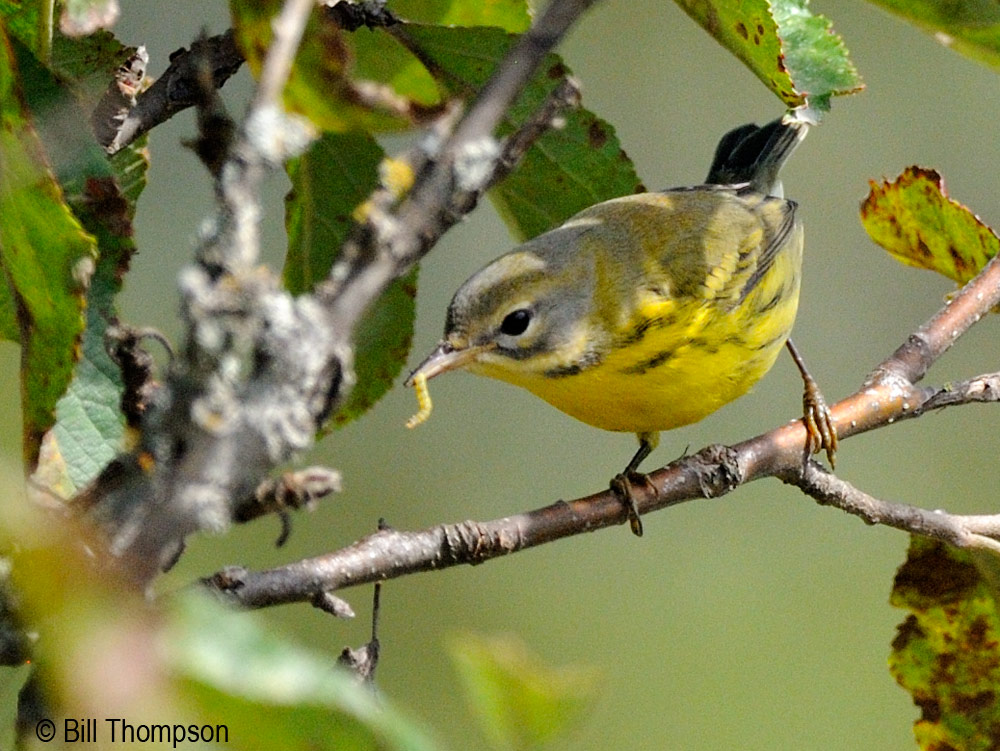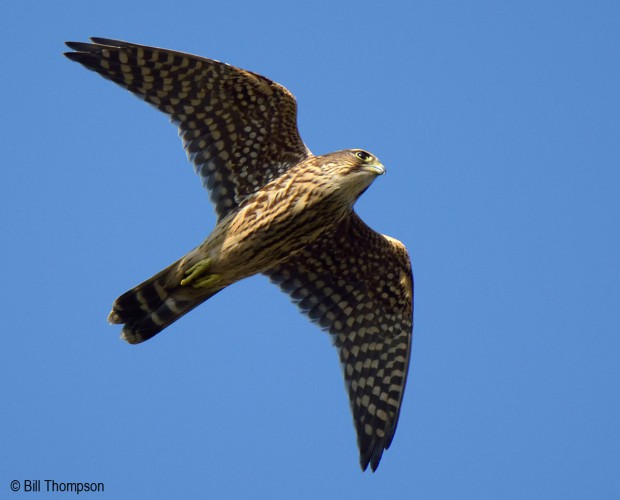Monhegan Migration Report No. 5: Life and Death in Flight
IN THE ANGLED, CLEANSING LIGHT OF AUTUMN, a Dickcissel posed for us — full frontal — atop a spreading Horse Chestnut near the Wharf here on Monhegan Island. A half hour later, we watched a Merlin, perched on a snag at the Ice Pond, eat a songbird it had just snatched from the skies … a Dickcissel.
Here in the Atlantic Ocean, the north winds deliver us songbirds, and the raptors take them away. No matter. On gentle winds this morning, more Dickcissels (flying in from a prairie in the Midwest or the Great Plains or somewhere else far away) arrived at dawn. We’re hearing their odd, buzzy, flat fzaapp notes overhead.
Yet sometimes the predator becomes prey. Across the harbor, over Manana, Monhegan’s biggest satellite island, an American Kestrel hovered yesterday in his customary style. As birders looked on, a Peregrine Falcon found an afternoon meal.
“Out of nowhere, as six of us watched with spotting scope, binocular, and eyeball, a Peregrine, like a lightning bolt, nailed this Kestrel in mid-hover,” reports one of the lucky birders, Glenn Jenks from Camden, Maine.
Alas, Kestrel and Dickcissel, we hardly knew ya. But so goes the drama of life and death in migration here on Monhegan. As it turns out, exquisite weather ain’t so great for birds. Since Saturday, the birding has been as slow as I’ve seen in nearly two decades of fall birding here (all the mayhem notwithstanding). Even the north winds Sunday and Monday carried few migrants. At one point in the day Wednesday, I had seen as many gull species as I had warbler species: five. (The “rare” gull out here now is Ring-billed Gull.)
That changed a bit this morning. Blackpoll Warblers, uttering their buzzy flight calls, arrived at dawn. We’re now seeing more Black-throated Green Warblers. More Swamp Sparrows. My first scoters of the season, three White-winged Scoters, flew offshore at Lobster Cove. A Blue-Gray Gnatcatcher remains at or around Monhegan House. At least one of the Yellow-crowned Night-Herons remains at the Ice Pond. But that Yellow-headed Blackbird vanished a week ago Wednesday. (But you can now find one on Cape Cod.)
Still, warblers are scarce here for the time being. How so? You know it’s an off year (so far) when our most oft-encountered warbler (apart from Yellow-rumped) is Prairie Warbler. They’ve making themselves so visible as only Prairie Warblers know how. And we’re most grateful for them.
Here’s my own list — 99 species — since my arrival on the island September 12. (I’m still missing some common or reliable Monhegan birds.) I’ve just completed a fabulous five days guiding a most wonderful group of birders — from as far away as Boise. What a gift to share this place with them. My next group arrives Friday. The gifting and birding continue. Read all my Monhegan migration reports here.
By the way, I’m not shooting many photos this trip. So I’m posting some of Bill Thompson’s work. Bill’s here on the island until nearly the end of the month. Check out Bill’s Flicker page.
Bird List – Monhegan Island, Maine
September 12-24, 2015
- American Black Duck
- Mallard
- Green-winged Teal
- Common Eider
- White-winged Scoter
- Ring-necked Pheasant
- Common Loon
- Northern Gannet
- Double-crested Cormorant
- Great Cormorant
- Black-crowned Night-Heron
- Yellow-crowned Night-Heron
- Osprey
- Northern Harrier
- Sharp-shinned Hawk
- Bald Eagle
- Spotted Sandpiper
- Greater Yellowlegs
- Whimbrel
- Least Sandpiper
- Black Guillemot
- Laughing Gull
- Ring-billed Gull
- Herring Gull
- Lesser Black-backed Gull
- Great Black-backed Gull
- Mourning Dove
- Ruby-throated Hummingbird
- Belted Kingfisher
- Downy Woodpecker
- Northern Flicker
- American Kestrel
- Merlin
- Peregrine Falcon
- Eastern Wood-Pewee
- Least Flycatcher
- Eastern Phoebe
- Great Crested Flycatcher
- Eastern Kingbird
- Blue-headed Vireo
- Warbling Vireo
- Philadelphia Vireo
- Red-eyed Vireo
- Blue Jay
- American Crow
- Common Raven
- Barn Swallow
- Black-capped Chickadee
- Red-breasted Nuthatch
- House Wren
- Carolina Wren
- Blue-gray Gnatcatcher
- Golden-crowned Kinglet
- Ruby-crowned Kinglet
- American Robin
- Gray Catbird
- Brown Thrasher
- Northern Mockingbird
- European Starling
- Cedar Waxwing
- Northern Waterthrush
- Black-and-white Warbler
- Tennessee Warbler
- Nashville Warbler
- Common Yellowthroat
- American Redstart
- Cape May Warbler
- Northern Parula
- Magnolia Warbler
- Bay-breasted Warbler
- Blackburnian Warbler
- Yellow Warbler
- Blackpoll Warbler
- Black-throated Blue Warbler
- Palm Warbler
- Pine Warbler
- Yellow-rumped Warbler
- Prairie Warbler
- Black-throated Green Warbler
- Wilson’s Warbler
- Canada Warbler
- Yellow-breasted Chat
- Lark Sparrow
- White-crowned Sparrow
- White-throated Sparrow
- Song Sparrow
- Northern Cardinal
- Rose-breasted Grosbeak
- Dickcissel
- Bobolink
- Red-winged Blackbird
- Yellow-headed Blackbird
- Common Grackle
- Brown-headed Cowbird
- Baltimore Oriole
- House Finch
- Purple Finch
- Pine Siskin
- American Goldfinch



Thanks.